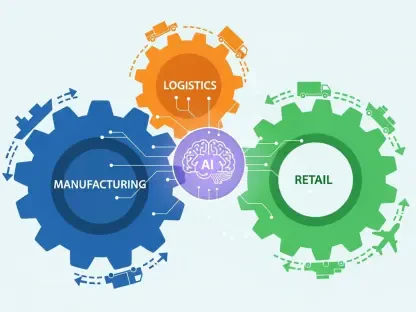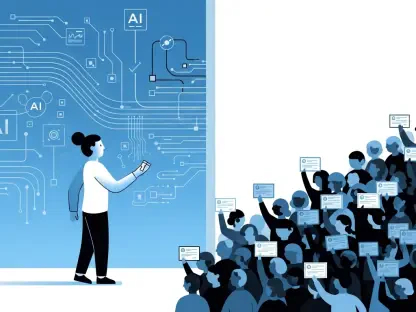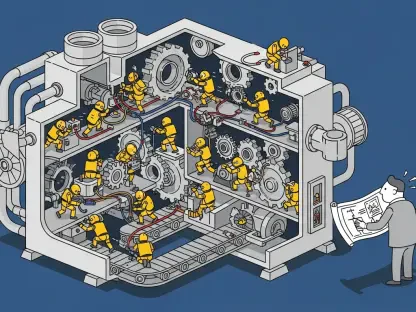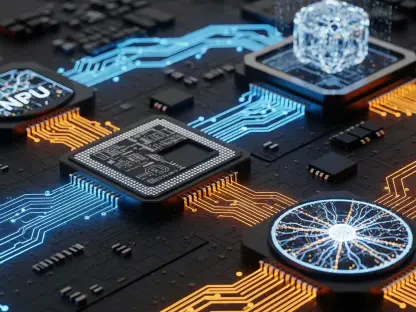In an era where over 75 billion connected devices are projected to operate at the edge by the end of this decade, the demand for real-time, efficient AI solutions has never been more pressing, especially as edge devices like factory sensors and wearable health monitors struggle with limited power and memory constraints. Traditional cloud-based AI often proves impractical for dynamic, on-the-spot decision-making in such environments. This guide unveils MicroAdapt, a groundbreaking technology designed to transform edge AI by enabling self-evolving, high-speed learning directly on compact hardware. Readers will gain a comprehensive understanding of how this innovation overcomes longstanding challenges, its step-by-step methodology, and its potential to reshape industries like manufacturing, automotive IoT, and healthcare. By exploring this guide, the aim is to equip readers with insights into adopting and leveraging cutting-edge AI solutions in resource-constrained environments.
Unveiling MicroAdapt: A Game-Changer for Edge AI
Edge AI technology stands at a pivotal moment, with MicroAdapt emerging as a transformative force that redefines how compact devices process and learn from data in real time. Unlike conventional systems tethered to cloud infrastructure, this innovation empowers small, resource-limited hardware to perform autonomous forecasting and adaptation without external support. Its significance lies in enabling immediate decision-making, a critical factor for applications where delays can lead to costly downtime or compromised safety, such as in industrial machinery or autonomous vehicles.
The impact of MicroAdapt extends across diverse sectors, promising to revolutionize manufacturing through predictive maintenance, enhance automotive IoT with smarter navigation systems, and improve healthcare via real-time monitoring in wearable devices. By embedding intelligence directly at the edge, it addresses the inefficiencies and privacy risks associated with constant cloud communication. This sets a new benchmark for what is possible in constrained environments, making advanced AI accessible to a broader range of applications.
This guide dives deep into the core aspects of this technology, breaking down its unique approach to data processing, highlighting its unmatched performance metrics, and illustrating practical use cases that demonstrate its versatility. Additionally, the exploration will cover industry trends shaping edge computing and the future potential of self-evolving systems. By the end, readers will have a clear roadmap of how this solution paves the way for smarter, more responsive technologies across various domains.
The Need for Edge AI Innovation: Challenges of Traditional Systems
Traditional AI systems, heavily reliant on cloud-based processing, face significant hurdles when deployed in edge environments where resources are scarce. High communication costs arise from the constant need to transmit data to remote servers, often straining budgets for large-scale IoT networks. Moreover, latency issues inherent in this setup hinder real-time responses, which are crucial for time-sensitive applications like emergency health alerts or vehicle collision avoidance.
Beyond financial and timing concerns, power consumption remains a critical barrier, as edge devices such as sensors or wearables typically operate on limited battery life, making energy-intensive cloud interactions unsustainable. Data privacy also emerges as a pressing issue, with sensitive information transmitted over networks at risk of breaches or unauthorized access. These combined limitations highlight why conventional setups struggle to meet the demands of dynamic, localized processing needs.
Static AI models, pre-trained in cloud environments, further exacerbate these challenges by lacking the flexibility to adapt to changing conditions on the ground. In fast-evolving scenarios, such as fluctuating factory outputs or shifting traffic patterns, these models quickly become outdated, unable to learn from new data without extensive retraining. This gap underscores the urgent demand for a solution like MicroAdapt, which prioritizes localized, efficient, and adaptive intelligence directly at the edge.
Breaking Down MicroAdapt’s Revolutionary Approach
MicroAdapt introduces a novel framework that reimagines AI deployment on edge devices, focusing on autonomous operation and continuous learning. At its core, the technology processes data locally, eliminating dependency on external servers and enabling compact hardware to handle complex tasks independently. This section provides a detailed, step-by-step breakdown of its methodology, offering clarity on how it achieves such remarkable results in constrained settings.
The approach stands out for its ability to evolve in real time, ensuring that predictions and decisions remain relevant even as environments shift. By integrating lightweight components and drawing inspiration from natural systems, it balances efficiency with precision. Readers will find a structured explanation of each phase, from data handling to model adaptation, shedding light on how this technology sets a new standard for edge AI.
Step 1: Decomposing Data Streams into Patterns
The initial phase of MicroAdapt’s process involves breaking down incoming, time-evolving data into distinct patterns directly on the edge device. This localized decomposition ensures that the system can handle streams of information without requiring cloud connectivity, a significant departure from traditional methods. By segmenting data into manageable components, the technology lays the groundwork for rapid analysis and response.
Capturing Real-Time Dynamics
A key aspect of this step is the focus on immediate data processing to maintain relevance in rapidly changing conditions. Whether monitoring machine performance on a factory floor or tracking vital signs through a wearable device, capturing real-time dynamics allows the system to stay aligned with current trends. This capability ensures that decisions are based on the most up-to-date information, a critical factor in high-stakes scenarios.
Step 2: Integrating Lightweight Modular Models
Following data decomposition, MicroAdapt employs multiple small, efficient models to represent various data streams, a stark contrast to the bulky, monolithic architectures of conventional AI. These modular units work collaboratively, each focusing on specific patterns, which enables the system to manage complexity without overwhelming limited hardware resources. This design prioritizes scalability and adaptability in diverse applications.
Balancing Efficiency with Accuracy
The modular structure is meticulously engineered to optimize resource usage while maintaining high predictive precision. By distributing tasks across smaller models, the technology avoids the heavy computational load associated with singular, large-scale systems, achieving impressive accuracy with minimal memory and power demands. This balance is essential for edge devices operating under strict constraints, ensuring performance is not sacrificed for efficiency.
Step 3: Enabling Continuous Self-Evolution
The final step centers on MicroAdapt’s capacity to learn from incoming data, adapt to environmental shifts, and discard obsolete components in real time. This self-evolving mechanism ensures that the system remains relevant over time, automatically updating its models as new patterns emerge. Such autonomy is a game-changer for edge AI, where manual intervention or cloud updates are often impractical.
Mimicking Biological Adaptability
Drawing inspiration from the adaptability of microorganisms, this phase incorporates principles of natural evolution into technological design. Just as simple organisms adjust to their surroundings for survival, MicroAdapt refines its models to suit changing data landscapes, enhancing resilience and innovation. This biological analogy underscores a forward-thinking approach, blending nature’s efficiency with cutting-edge engineering to solve modern challenges.
Key Advantages of MicroAdapt at a Glance
MicroAdapt offers a range of compelling benefits that distinguish it from traditional AI systems, making it an ideal choice for edge applications. These advantages are summarized below for quick reference, highlighting its superiority in performance and efficiency:
- Achieves processing speeds up to 100,000 times faster than conventional deep learning methods, ensuring rapid decision-making.
- Delivers accuracy rates improved by up to 60% compared to existing prediction techniques, enhancing reliability.
- Operates efficiently with less than 1.95GB of memory and under 1.69W of power on a Raspberry Pi 4, proving its suitability for low-resource environments.
- Supports autonomous real-time learning without reliance on cloud infrastructure, addressing privacy and latency concerns.
MicroAdapt in the Bigger Picture: Industry Trends and Future Potential
The rise of decentralized AI and edge computing marks a significant shift in the tech landscape, with a growing emphasis on reducing latency and bolstering security through localized processing. MicroAdapt aligns seamlessly with this trend, offering a solution that not only meets current demands but also anticipates future needs for faster, safer data handling. Its ability to operate independently on compact devices positions it as a cornerstone of this evolving paradigm, driving efficiency across multiple sectors.
Specific applications underscore its versatility, from enabling predictive maintenance in manufacturing to prevent equipment failures, to supporting autonomous driving in automotive IoT by adapting to real-time road conditions. In healthcare, it enhances wearable devices for continuous health monitoring, providing personalized insights without external data transfers. These use cases illustrate how the technology addresses unique industry challenges, paving the way for smarter, more responsive systems.
Despite its promise, challenges such as scalability across diverse hardware platforms remain a consideration for broader adoption. Ensuring compatibility with varying device specifications could require further refinement. Looking ahead from 2025 to 2027, ongoing developments in self-evolving AI systems are expected to tackle these hurdles, potentially integrating even more advanced adaptive mechanisms. The trajectory suggests a future where edge AI becomes increasingly autonomous, with MicroAdapt leading the charge in innovation.
Embracing the Edge AI Future with MicroAdapt
Looking back, the journey through MicroAdapt’s transformative impact on edge AI revealed a clear path from overcoming traditional limitations to achieving unparalleled performance in constrained settings. Each step, from decomposing data streams to enabling continuous self-evolution, showcased how this technology redefined what compact devices could accomplish. The exploration of its advantages and industry applications further highlighted its role as a catalyst for change across diverse fields.
Moving forward, the focus shifts to actionable next steps, such as exploring partnerships in manufacturing, mobility, and healthcare to integrate this technology into existing systems. Stakeholders are encouraged to evaluate how localized AI can enhance operational efficiency or improve user experiences in their specific contexts. Additionally, keeping abreast of advancements through industry collaborations will be crucial for staying competitive in this rapidly evolving space.
As a final consideration, the potential for customizing MicroAdapt to niche applications offers an exciting avenue for innovation. Tailoring its modular framework to unique challenges, whether in remote environmental monitoring or personalized consumer tech, could unlock new possibilities. This forward-looking perspective ensures that the momentum gained from understanding this technology translates into tangible progress in real-world scenarios.









